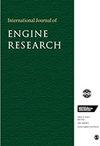Piston ring and cylinder liner scuffing analysis in dual-fuel low-speed engines considering liner deformation and tribofilm evolution
IF 2.1
4区 工程技术
Q2 ENGINEERING, MECHANICAL
引用次数: 0
Abstract
The piston ring and cylinder liner (PRCL) system in larger-bore low-speed marine engines frequently experiences scuffing failures, which significantly decrease the engine reliability. To understand this failure mechanism, a scuffing failure model subjected to the PRCL system was developed considering multidisciplinary coupling effects that integrate asperity contact, hydrodynamic lubrication, tribochemistry reactions, thermal effects, friction, and surface wear. The impacts of large-scale deformation and gas-combustion mode on the scuffing performances of the PRCL system were examined. The key findings indicate that the larger-scale liner deformation can markedly reduce oil film thickness and exacerbate local asperity contact, influencing the evolution of the tribofilm by increasing the removal process. Under gas-combustion mode, the oil film thickness is even lower, and the asperity contact pressure further increases due to a more starved lubrication state and higher combustion temperature. This leads to tribofilm breakdown and severe wear near the ring opening area, which are aligning with the full-scale experimental results with scuffing failure.考虑到衬垫变形和三膜演变的双燃料低速发动机活塞环和气缸套擦伤分析
大口径低速船用发动机的活塞环和气缸套(PRCL)系统经常出现擦伤故障,严重降低了发动机的可靠性。为了解这一失效机理,我们开发了一个针对 PRCL 系统的擦伤失效模型,该模型考虑了多学科耦合效应,包括表面接触、流体动力润滑、摩擦化学反应、热效应、摩擦和表面磨损。研究了大尺度变形和气体燃烧模式对 PRCL 系统磨损性能的影响。主要研究结果表明,衬垫的大尺度变形会明显降低油膜厚度,加剧局部表面接触,通过增加去除过程来影响三膜的演化。在气体燃烧模式下,油膜厚度更低,由于润滑状态更加匮乏和燃烧温度更高,非球面接触压力进一步增大。这导致三膜破裂,环开口区附近出现严重磨损,这与全尺寸实验结果一致。
本文章由计算机程序翻译,如有差异,请以英文原文为准。
求助全文
约1分钟内获得全文
求助全文
来源期刊

International Journal of Engine Research
工程技术-工程:机械
CiteScore
6.50
自引率
16.00%
发文量
130
审稿时长
>12 weeks
期刊介绍:
The International Journal of Engine Research publishes high quality papers on experimental and analytical studies of engine technology.
 求助内容:
求助内容: 应助结果提醒方式:
应助结果提醒方式:


